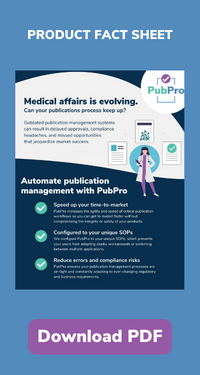
Pharmaceutical organizations must constantly evolve in order to stay competitive in the market and compliant with regulations.
Recent years have seen significant change in the role of medical affairs teams in the pharmaceutical industry. COVID-19 accelerated these changes. As a result, many medical affairs departments now face a pressing need to meet shifting expectations.
Technology is in a unique position to alleviate some of the growing pains that medical affairs teams experience as they take on greater responsibilities. Process automation, in particular, can play a valuable role in streamlining and improving the efficiency of medical affairs workflows.
With process automation solutions, medical affairs leaders can:
- Deliver actionable insights to key decision makers
- Reduce administrative overhead to enable team members to spend more time on stakeholder engagement
- Digitally engage HCP’s and KOL’s increasing the capacity of the team to engage these key stakeholders
- Streamline collaboration across departments to speed up the new drug development
- Contain costs, by introducing new efficiencies
The role of process automation is becoming more critical as the field of medical affairs continues to grow. In this article, we’ll walk through why and how medical affairs is changing (including the role played by the COVID-19 pandemic), and dive deep into how technology must adapt to meet the needs of this growing sector.
How medical affairs is changing
Historically, medical affairs provided support to the research and commercial pillars of pharmaceutical and medical device companies, but that's changed drastically over the past decade.
These organizations are faced with increasing regulatory pressures, rising drug development costs, and a faster-paced competitive market. To meet the increasing market demands, medical affairs departments are facing greater expectations and workloads without a proportionate increase in budgets.
To address this challenge, companies are turning to process automation solutions to help medical affairs teams do more with less. By automating routine tasks and optimizing resource utilization, medical affairs teams can focus on delivering high-quality, credible information to physicians and patients in a timely and efficient manner.
Medical affairs is brought to the table earlier in the drug development process to foster more seamless collaboration with other departments and contribute to strategic decision-making.
COVID-19's impact on medical affairs

The changes to the medical affairs industry have been in the works for the past decade, but the COVID-19 pandemic galvanized the situation further by rewriting the script on (a) how pharma develops and brings drugs to market, and (b) how the HCP/MSL engagement model functions.
Developing and bringing drugs to market
When we talk about how the pandemic changed the way drugs are developed and brought to market, there’s no way not to mention the impact that Operation Warp Speed (OWS) had on the time-to-market speed for pharmaceutical products.
OWS was initiated by the United States government in spring 2020 to help accelerate the development and distribution of testing, vaccines, and therapies for COVID-19.
In addition to saving millions of lives and helping gain better control over the pandemic, the operation demonstrated that it was possible to move pharmaceutical products through the development and approval process much faster than previously thought.
Of course, developing a vaccine to combat an active pandemic is a unique situation. Most drugs do not warrant emergency use authorization, nor are they backed by the whopping $10 billion budget granted to Operation Warp Speed by the CARES act.
Even so, it’s an incredibly valuable case study for medical affairs teams and their colleagues to consider in medical planning. The process for developing and approving drugs often takes between 10-15 years. Imagine a pharmaceutical market that reduces that timeline estimate by half.
That's not only a game changer for patients – it's a competitive advantage for businesses in the pharmaceutical industry.
While the conditions for developing drugs under a pandemic are not replicable for most other drugs, investment in automation technology can emulate some of these fast-paced outcomes. Upgrading medical affairs software with automated solution can not only help teams move faster and more efficiently, but they also provide a better experience for users.
Shifts in the HCP/MSL engagement model
The first year of the pandemic marked a significant increase in digital engagement interactions between healthcare providers (HCPs) and medical science liaisons (MSLs).
Due to pandemic-related travel restrictions, MSLs were now conducting the vast majority (or in some cases, all) of their work remotely.
This new mode of working meant that they could easily engage with multiple HCPs in a single day.
But how did HCPs feel about this change?
According to a June 2020 EU5 report, 55 percent of HCPs said they preferred transitioning to virtual engagements with MSLs. However, only 30 percent of HCPs expressed satisfaction with the quality and value of these digital interactions.
These stats illustrate that the demand for digital MSL engagements is there, but there is still work to be done to ensure these experiences are useful for HCPs.
In the white paper, “Beyond the Field: Evolving Field Medical Engagement and Talent for the Future,” the Medical Affairs Professional Society (MAPS) suggests that the increase in digital MSL engagement presents a golden opportunity for the medical affairs industry to take steps to improve their processes:
“The move to virtual conferences and meetings, where data is not consumed in real-time, has highlighted an opportunity for the industry to revisit compliance, review and approval processes to keep pace with information needs. The timing and consumption of information changes significantly when it’s available online for a clinician to download at their convenience. […] This amplifies the need for the accurate and accelerated review/approval of materials to accommodate the speed that data is consumed virtually.”
The most effective way for pharmaceutical organizations to grasp this opportunity and satisfy the needs of KOLs is to prioritize technology investments that can improve the quality of digital engagements.
Oversight and compliance challenges

Another critical way medical affairs is changing comes down to compliance and oversight. As scientists and pharmaceutical leaders seek innovative treatments as quickly and safely as possible, the regulatory environment grows more complex by the day.
A significant reason for this complexity has been the outgrowth of pharma applications to more technical, niched scientific areas. Today, pharmaceutical companies are making important advancements in the realms of biologics, mRNA technologies, gene therapies, and more.
These advancements necessitate greater scientific rigor and oversight for medical affairs processes across the board – which is important for safety and validation, as well as for ensuring the sponsoring organization can remain competitive and reduce their legal risk.
The challenge is that as regulations grow more robust and complex, an organization’s SOPs must evolve to meet those requirements. This is another area in which technology must play a critical role.
Investing in purpose-built technology can lessen the challenge of updating SOPs to match the complexities of the moment, as well as help teams work faster because automation makes it easier to meet compliance requirements and check for debarments.
Medical affairs technology needs are also changing
In addition to the impact of COVID-19 and the pharmaceutical industry’s ever-changing regulatory requirements, medical affairs faces greater pressure to provide better customer experiences (CX) and user experiences (UX) to physicians, payers, regulators, journals, and congresses that must access and review drug information digitally.
There are a variety of different tools and technologies that medical affairs professionals can use to improve efficiency and productivity both within their organization and outside of it. These technologies range from custom applications to licensed outsourced solutions, but choosing the right ones is not always simple.
Pharmaceutical companies face three main challenges when researching and selecting technologies:
1. Identifying functionality that can evolve with them
With how quickly medical affairs teams are growing and changing, it’s imperative that the technology they use can evolve with them. That is why any technological solutions under consideration should:
- Meet the emerging needs of the medical affairs professionals.
- Offer the flexibility to customize solutions within its architecture.
For example, in our discussions with medical affairs leaders about their publication planning systems, one of their primary motivations for seeking out a new technology is frustration with the functionality of their existing solutions, including out of date user interfaces, failure to keep up with changing business or regulatory requirements, and insufficient customer support. These incumbent solutions are often longstanding in the industry but have grown complacent, neglecting to prioritize innovative improvements.
 As the role of medical affairs grows more complex and wider in scope, these mission critical teams are chafing against the confines of technology that can no longer meet their needs and expectations.
As the role of medical affairs grows more complex and wider in scope, these mission critical teams are chafing against the confines of technology that can no longer meet their needs and expectations.
That is why our team of process automation experts created a new publication planning solution, PubPro.
PubPro is designed to improve the speed and efficiency of publication planning processes for medical affairs and medical communications teams. Customers can reduce their publication planning costs by as much as 50%, in addition to solving high stakes compliance issues.
2. Overcoming the perceived burden of switching technologies
Another major hurdle to overcome involves all the perceived barriers associated with switching technologies.
When an organization has used the same system for managing a process for many years, it can feel daunting to make a switch to a new solution. Even if the new solution promises outstanding improvements in efficiency, accuracy, and user experience, organizations may feel tethered to their existing systems and processes for "sunk cost” reasons or they may rationalize that it’s simply “not the right time to shake things up.”
There may also be concerns about the transition itself. Will the implementation and training period cause disruptions to critical projects? How difficult will it be to migrate from the old system? How challenging will it be to train employees on the new system?
The fact is, medical affairs leaders do not have the luxury of taking their time to onboard software slowly, which is why technology partners must prioritize delivering a fast and seamless transition to their customers.
3. Ensuring seamless integration with existing technology
One of the functions of a medical affairs team is to help connect various departments at their organization with external stakeholders, such a HCPs, KOLs, and patients.
In order for medical affairs teams to work effectively, the organization's data must be able to move seamlessly across departmental and organizational boundaries while maintaining privacy and compliance standards.
That is why it is imperative that technology buyers at these organizations ensure they are making investments that can easily integrate with existing tools and legacy systems. The end result should be a streamlined, cross-functional workflow that provides clear visibility into any bottlenecks.
The ideal choice of technology to meet these needs should provide multiple options to enable single sign-on and multiple formats for exchange with the existing technology platforms.
Maximizing competitive advantages
With how rapidly the medical affairs landscape is changing, it’s important for pharmaceutical leaders to bring in technologies that can match the gait of this fast-paced growth and be ready to adapt quickly to new developments and requirements.
Ready to level up your medical affairs team? Contact our team of process automation experts to learn more about implementing one of our process automation solutions at your organization.



